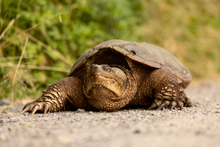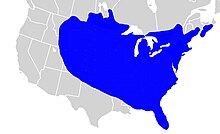
Back سلحفاة نهاشة شائعة Arabic سلحفاه نهاشه شائعه ARZ Кайманова костенурка Bulgarian Tortuga mossegadora Catalan Chelydra serpentina CEB He'óonéma'ëno CHY Kajmanka dravá Czech Schnappschildkröte German Serpentotestudo Esperanto Chelydra serpentina Spanish
| Common snapping turtle | |
|---|---|

| |
| Snapping turtle crossing the trail at John Heinz NWR | |
| Scientific classification | |
| Domain: | Eukaryota |
| Kingdom: | Animalia |
| Phylum: | Chordata |
| Class: | Reptilia |
| Order: | Testudines |
| Suborder: | Cryptodira |
| Family: | Chelydridae |
| Genus: | Chelydra |
| Species: | C. serpentina
|
| Binomial name | |
| Chelydra serpentina | |

| |
| Native range map of C. serpentina | |
| Synonyms | |
| |
The common snapping turtle (Chelydra serpentina) is a species of large freshwater turtle in the family Chelydridae. Its natural range extends from southeastern Canada, southwest to the edge of the Rocky Mountains, as far east as Nova Scotia and Florida. The present-day Chelydra serpentina population in the Middle Rio Grande, suggests that common snapping turtle has been present in this drainage since at least the seventeenth century and is likely native.[3] The three species of Chelydra and the larger alligator snapping turtles (genus Macrochelys) are the only extant chelydrids, a family now restricted to the Americas. The common snapping turtle, as its name implies, is the most widespread.[4]
The common snapping turtle is noted for its combative disposition when out of the water with its powerful beak-like jaws, and highly mobile head and neck (hence the specific epithet serpentina, meaning "snake-like"). In water, it is likely to flee and hide underwater in sediment. The common snapping turtle has a life-history strategy characterized by high and variable mortality of embryos and hatchlings, delayed sexual maturity, extended adult longevity, and iteroparity (repeated reproductive events) with low reproductive success per reproductive event.[5]
Females, and presumably also males, in more northern populations mature later (at 15–20 years) and at a larger size than in more southern populations (about 12 years). Lifespan in the wild is poorly known, but long-term mark-recapture data from Algonquin Park in Ontario, Canada, suggest a maximum age over 100 years.[5]
- ^ van Dijk, P.P. (2016) [errata version of 2012 assessment]. "Chelydra serpentina ". IUCN Red List of Threatened Species. 2012: e.T163424A97408395. doi:10.2305/IUCN.UK.2012.RLTS.T163424A18547887.en. Retrieved 4 December 2017.
- ^ "Appendices | CITES". cites.org. Retrieved 2023-03-01.
- ^ Jones, E. L.; Steele, L. W.; Conrad, C. (2022). "Archaeological Data Suggest Seventeenth-Century Presence of Common Snapping Turtle (Chelydra serpentina) in the Middle Rio Grande". Western North American Naturalist. 82 (3): 611–615. doi:10.3398/064.082.0317.
- ^ Ernst, C.H. (2008). "Systematics, Taxonomy, and Geographic Distribution of the Snapping Turtles, Family Chelydridae". In A.C. Styermark; M.S. Finkler; R.J. Brooks (eds.). Biology of the Snapping Turtle (Chelydra serpentina). Johns Hopkins University Press. pp. 5–13. ISBN 9780801887246.
- ^ a b "COSEWIC Assessment and Status Report on the Snapping Turtle Chelydra serpentina" (PDF).
© MMXXIII Rich X Search. We shall prevail. All rights reserved. Rich X Search
